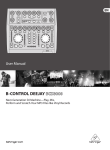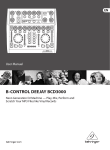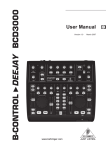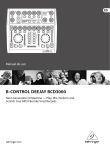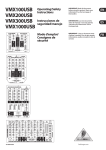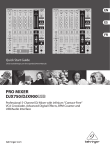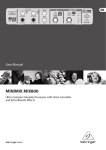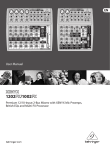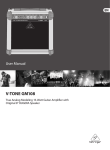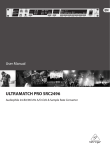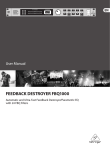Download Behringer B-Control Deejay BCD3000 User manual
Transcript
User Manual B-CONTROL DEEJAY Next-Generation DJ Machine—Play, Mix, Perform and Scratch Your MP3 Files like Vinyl Records 2 B-CONTROL DEEJAY BCD3000 User Manual Table of Contents Thank you........................................................................ 2 Important Safety Instructions....................................... 3 Legal Disclaimer.............................................................. 3 Limited warranty............................................................. 3 1. Introduction................................................................ 4 2. Installation.................................................................. 5 3. Control Elements and Connections.......................... 6 4. The Software............................................................... 8 5. Operation.................................................................. 10 6. MIDI Control.............................................................. 13 7. Audio Connections................................................... 14 8. Specifications............................................................ 15 Thank you Thank you for expressing your confidence in us by purchasing the B-CONTROL. The BCD3000 is a 4-channel audio interface, and enables control over virtually all current DJ applications by using the powerful virtual mixer (TRAKTOR 3 LE software included). Despite its compact size, it offers a fully fitted controller console with 24-bit A/D und D/A converters, a full-speed USB audio interface with a high-grade microphone preamplifier, a 3-band kill EQ for each channel, ultra-precise faders, a smooth crossfader and talkover function. 3 B-CONTROL DEEJAY BCD3000 User Manual Important Safety Instructions Terminals marked with this symbol carry electrical current of sufficient magnitude to constitute risk of electric shock. Use only high-quality professional speaker cables with ¼" TS or twist-locking plugs pre-installed. All other installation or modification should be performed only by qualified personnel. This symbol, wherever it appears, alerts you to the presence of uninsulated dangerous voltage inside the enclosure - voltage that may be sufficient to constitute a risk of shock. This symbol, wherever it appears, alerts you to important operating and maintenance instructions in the accompanying literature. Please read the manual. Caution To reduce the risk of electric shock, do not remove the top cover (or the rear section). No user serviceable parts inside. Refer servicing to qualified personnel. Caution To reduce the risk of fire or electric shock, do not expose this appliance to rain and moisture. The apparatus shall not be exposed to dripping or splashing liquids and no objects filled with liquids, such as vases, shall be placed on the apparatus. 9. Do not defeat the safety purpose of the polarized or grounding-type plug. A polarized plug has two blades with one wider than the other. A grounding-type plug has two blades and a third grounding prong. The wide blade or the third prong are provided for your safety. If the provided plug does not fit into your outlet, consult an electrician for replacement of the obsolete outlet. 10. Protect the power cord from being walked on or pinched particularly at plugs, convenience receptacles, and the point where they exit from the apparatus. 11. Use only attachments/accessories specified by the manufacturer. 12. Use only with the cart, stand, tripod, bracket, or table specified by the manufacturer, or sold with the apparatus. When a cart is used, use caution when moving the cart/apparatus combination to avoid injury from tip-over. 13. Unplug this apparatus during lightning storms or when unused for long periods of time. 14. Refer all servicing to qualified service personnel. Servicing is required when the apparatus has been damaged in any way, such as power supply cord or plug is damaged, liquid has been spilled or objects have fallen into the apparatus, the apparatus has been exposed to rain or moisture, does not operate normally, or has been dropped. 15. The apparatus shall be connected to a MAINS socket outlet with a protective earthing connection. 16. Where the MAINS plug or an appliance coupler is used as the disconnect device, the disconnect device shall remain readily operable. Caution These service instructions are for use by qualified service personnel only. To reduce the risk of electric shock do not perform any servicing other than that contained in the operation instructions. Repairs have to be performed by qualified service personnel. 1. Read these instructions. 2. Keep these instructions. 3. Heed all warnings. 4. Follow all instructions. 5. Do not use this apparatus near water. 6. Clean only with dry cloth. 7. Do not block any ventilation openings. Install in accordance with the manufacturer’s instructions. 8. Do not install near any heat sources such as radiators, heat registers, stoves, or other apparatus (including amplifiers) that produce heat. LEGAL DISCLAIMER TECHNICAL SPECIFICATIONS AND APPEARANCES ARE SUBJECT TO CHANGE WITHOUT NOTICE AND ACCURACY IS NOT GUARANTEED. BEHRINGER, KLARK TEKNIK, MIDAS, BUGERA, AND TURBOSOUND ARE PART OF THE MUSIC GROUP (MUSIC-GROUP.COM). ALL TRADEMARKS ARE THE PROPERTY OF THEIR RESPECTIVE OWNERS. MUSIC GROUP ACCEPTS NO LIABILITY FOR ANY LOSS WHICH MAY BE SUFFERED BY ANY PERSON WHO RELIES EITHER WHOLLY OR IN PART UPON ANY DESCRIPTION, PHOTOGRAPH OR STATEMENT CONTAINED HEREIN. COLORS AND SPECIFICATIONS MAY VARY FROM ACTUAL PRODUCT. MUSIC GROUP PRODUCTS ARE SOLD THROUGH AUTHORIZED FULLFILLERS AND RESELLERS ONLY. FULLFILLERS AND RESELLERS ARE NOT AGENTS OF MUSIC GROUP AND HAVE ABSOLUTELY NO AUTHORITY TO BIND MUSIC GROUP BY ANY EXPRESS OR IMPLIED UNDERTAKING OR REPRESENTATION. THIS MANUAL IS COPYRIGHTED. NO PART OF THIS MANUAL MAY BE REPRODUCED OR TRANSMITTED IN ANY FORM OR BY ANY MEANS, ELECTRONIC OR MECHANICAL, INCLUDING PHOTOCOPYING AND RECORDING OF ANY KIND, FOR ANY PURPOSE, WITHOUT THE EXPRESS WRITTEN PERMISSION OF MUSIC GROUP IP LTD. ALL RIGHTS RESERVED. © 2013 MUSIC Group IP Ltd. Trident Chambers, Wickhams Cay, P.O. Box 146, Road Town, Tortola, British Virgin Islands LIMITED WARRANTY For the applicable warranty terms and conditions and additional information regarding MUSIC Group’s Limited Warranty, please see complete details online at www.music-group.com/warranty. 4 B-CONTROL DEEJAY BCD3000 User Manual 1. Introduction The BCD3000 features 2 first-class Phono preamps, one of which is switchable to the CD input. The sophisticated Headphone section includes a PFL function as well as the option to monitor the master output signal directly. Start/Stop, Cue, Loop and Pitch-Bend have dedicated controls to support your intuitive performance, plus 4 user-assignable controls and buttons are available in the Effects section. Benefit now from the huge potential that modern laptops have to offer, with the real-time accessibility to digital sound files of different formats! ◊ The following user’s manual is intended to familiarize you with the unit’s control elements, so that you can master all the functions. After having thoroughly read the user’s manual, store it in a safe place for future reference. 1.1 Before you get started 1.1.1 Shipment The BCD3000 was carefully packed at the assembly plant to assure secure transport. Should the condition of the cardboard box suggest that damage may have taken place, please inspect the unit immediately and look for physical indications of damage. ◊ Damaged equipment should NEVER be sent directly to us. Please inform the dealer from whom you acquired the unit immediately as well as the transportation company from which you took delivery. Otherwise, all claims for replacement/repair may be rendered invalid. ◊ To assure optimal protection of your B-CONTROL during use or transport, we recommend utilizing a carrying case. ◊ Please always use the original packaging to avoid damage due to storage or shipping. ◊ Never let unsupervised children play with the B-CONTROL or with its packaging. ◊ Please dispose of all packaging materials in an environmentally friendly fashion. 1.1.2 Initial operation Please make sure the unit is provided with sufficient ventilation, and never place the B-CONTROL on top of an amplifier or in the vicinity of a heater to avoid the risk of overheating. A power supply unit which meets the necessary safety requirements is enclosed for connecting the B-CONTROL to the mains. Important information for installation ◊ The sound quality may diminish within the range of powerful broadcasting stations and high-frequency sources. Increase the distance between the transmitter and the device, and use shielded cables for all connections. 1.1.3 Online registration Please register your new BEHRINGER equipment right after your purchase by visiting http://behringer.com and read the terms and conditions of our warranty carefully. Should your BEHRINGER product malfunction, it is our intention to have it repaired as quickly as possible. To arrange for warranty service, please contact the BEHRINGER retailer from whom the equipment was purchased. Should your BEHRINGER dealer not be located in your vicinity, you may directly contact one of our subsidiaries. Corresponding contact information is included in the original equipment packaging (Global Contact Information/European Contact Information). Should your country not be listed, please contact the distributor nearest you. A list of distributors can be found in the support area of our website (http://behringer.com). Registering your purchase and equipment with us helps us process your repair claims more quickly and efficiently. Thank you for your cooperation! 1.2 Features with Mac OS X When using the BCD3000 with a Mac, there are several limitations in comparison to using it with Windows. • Hardware driver is not required. • Input A is only switchable between the Microphone and Phono input by using MIDI commands. • The outputs are dedicated: channels 1-2 are always routed to MASTER OUT and channels 3-4 are routed to PHONES. • The properties of the MIDI interface and LED cannot be reconfigured. • Control Panel software to control the latency is not required. 1.3 System requirements Minimum system requirements for PC: • Processor: Pentium III / Athlon XP 1 GHz • 1 free USB port (USB 1.1 or higher) • CD drive • 512 MB RAM • OS: Windows XP SP 2 Minimum system requirements for Mac: • Processor: G4 1.5 GHz or Dual Core 1.6 GHz • 1 free USB port (USB 1.1 or higher) • CD drive • 512 MB RAM • OS: Mac OS X 10.4 5 B-CONTROL DEEJAY BCD3000 User Manual 2. Installation 2.1.2 Installing TRAKTOR 3 LE on Windows XP When using Windows XP, please continue with Chapter 2.1. Mac users continue with Chapter 2.2. Installation: 2.1 Installation on Windows XP First, install the driver on your computer. The driver is provided on the included “BCD3000” CD-ROM. 1. Insert the “TRAKTOR 3 LE” CD in the CD/DVD drive. 2. Open Windows Explorer (My Computer > right mouse button > Explorer). 3. In Windows Explorer, select the drive containing the “TRAKTOR 3 LE” CD (for example, double-click “DVD drive (D:)”). 2.1.1 Hardware installation on Windows XP 4. Double-click the setup file (.exe) to start the installation process. 1. Connect the BCD3000 to a free USB port on your computer. 5. Follow the on-screen installation instructions. 2. Start Windows XP. After the installation, the TRAKTOR 3 LE software is ready for use. 3. Once your computer has booted, switch on the BCD3000 and wait for the device to be detected by the system. The “Found New Hardware Wizard” opens up. Now, you can run the TRAKTOR 3 LE program via the Start menu: Start > All Programs > Native Instruments TRAKTOR 3 LE > TRAKTOR 3 LE. 4. Close all applications, in particular those running in the background, such as virus scanner software. 5. Put the driver/software CD-ROM supplied with the unit into the CD/DVD drive. 6. In the first window that opens up, select “Automatic software installation” and click on “Next >”. 7. If the error message “Driver software has not passed Windows Logo testing” appears, ignore it and click on “Continue anyway” to install the first part of the driver. 2.2 Installation on Mac OS X 2.2.1 Hardware installation on Mac OS X 1. Connect the BCD3000 to a free USB port of your Mac. 2. The BCD3000 is now ready for use. When “Audio MIDI Setup” is open, you see an icon for the BCD3000. You can find the Audio MIDI Setup application under Macintosh HD > Applications > Utilities > Audio MIDI Setup. 8. Then click on “Finish”. 9. Now the installation window for the WDM driver of the BCD3000 appears on the screen. Again, select “Automatic software installation” and click on “Next >”. 10. If the error message is shown again (“Driver software has not passed Windows Logo testing”), ignore it and click on “Continue anyway”. 11. The second part of the driver is installed. 12. Click on “Finish”. The driver installation is complete. After a system reboot, the BCD3000 is ready for use. ◊ Note for notebook users: If you encounter problems operating the BCD3000 from your system, please disable the following settings: 1. In the Device Manager (right click on My Computer > Manage > Device Manager), click option “Batteries” > disable Microsoft ACPI-Compliant Control Method Battery. 2. In the USB Controller, do the following for each single USB Root Hub: Right click > Properties > Power management > disable the option “Allow the computer to turn off this device to save power”. 3. Restart Windows XP. Now the system performance of your computer should be more stable. Fig. 2.1: The BCD3000 in Audio MIDI Setup 2.2.2 Installing TRAKTOR 3 LE on Mac OS X 1. Insert the “TRAKTOR 3 LE” CD in the CD/DVD drive. 2. Double-click the TRAKTOR 3 LE CD icon to display the contents of the CD. 3. Double-click the TRAKTOR 3 LE setup file. 4. The program displays a welcome screen. Press “Continue”. A dialog appears in which you can specify the type of installation and the target folder. 5. Follow the on-screen instructions. After the installation, the TRAKTOR 3 LE software is now ready for use. You can run the TRAKTOR 3 LE program via Macintosh HD > Programs > TRAKTOR 3 LE and double-click the “TRAKTOR 3 LE” icon. 6 B-CONTROL DEEJAY BCD3000 User Manual 3. Control Elements and Connections The various control elements of your BCD3000 are described in this chapter. All controls and connections are explained in detail, and there are several useful tips on their use. (2) (1) (4) (9) (5) (10) (6) (13) (7) (11) (8) (12) (17) (19) (18) (15) (3) (16) (22) (21) (33) (32) (23) (24) (25) (34) (26) (27) (31) (30) (20) (28) (29) (14) Fig. 3.1: The BCD3000’s control elements 3.1 Control surface The microphone input section (MIC INPUT) (1) Set the volume of the microphone signal with the MIC LEVEL control. (2) The CLIP LED illuminates as soon as the microphone signal level is too high and could possibly cause audible distortion. If this happens, slightly turn the MIC LEVEL control counter-clockwise. (3) The microphone input section has a 2-band equalizer (EQ HIGH for high frequencies and EQ LOW for low frequencies). (4) Select the input source with the buttons EXT IN A / EXT IN B. If the buttons are not pressed (LEDs are off), the Deck A and B signals in the TRAKTOR 3 LE software are played back. If you press one of the buttons (LEDs light up), the analog input signal of the BCD3000 is passed on to the corresponding deck in the TRAKTOR software. On Deck A, the Phono input A (36) or microphone signal is played back. On Deck B, you hear the input B signal (Phono or CD). You can either specify the input source for Deck A in the Control Panel (Windows only) or with MIDI commands (see Chapter 6.3). For Deck B, select the input source on the rear panel of the device (Phono/Line switch (38) ). The FX CONTROL section This section allows you to select and control effects with the BCD3000. In the manual of the TRAKTOR 3 LE software (as PDF in the TRAKTOR 3 LE folder under “Documentation”), you can find the available effects. (9) The ON button activates the effects section. (10) The FX ▼ button switches to the preceding available effect. (11) The FX ▲ button switches to the next available effect. The assignment of the four controls (5) – (8) ) and the ACTION button (12) depends on the selected effect. 7 B-CONTROL DEEJAY BCD3000 User Manual The OUTPUT section (13) The CUE A and CUE B buttons allow you to listen in on Deck A or B. Keep the respective button pressed to feed the signal of Deck A or Deck B to the Headphone output (14). (14) The PHONES output (¼" stereo connector) is used for connecting headphones. (15) The PHONES VOL control lets you adjust the volume level of the Headphone output (14). (16) The PHONES MIX control is used to adjust the relation between the stereo MASTER OUT and MONITOR OUT signal. When the control is turned fully left, you hear the MONITOR OUT signal, and when turned fully right, you hear the MASTER OUT signal. (17) The KEY DECK A + B button is used to activate the “Key Lock” function of the TRAKTOR 3 LE software. The “pitching” of a track usually changes both the music’s speed (tempo) and pitch/key. The “Key Lock” function (or Master Tempo) makes sure the pitch is retained. Find more on this topic in the PDF manual of TRAKTOR 3 LE. (18) Set the volume of the MASTER output with the MASTER OUTPUT control. (19) The POWER ON-LED lights up when the BCD3000 is switched on. The deck sections A and B The control elements of decks A and B are the same. However, some of them are grouped the opposite way round. We will therefore describe the elements to only once. All of these control elements refer to the software functions which can be “remotely” controlled from the BCD3000. (20) The CROSSFADER is used to fade between deck A and deck B. (29) Press the PLAY button to begin playback. Press this button a second time to stop playback. By pressing PLAY again, playback continues from the point at which it was stopped. Every time playback is stopped, the cue point is placed at the current song position. You can find information on the CUE function in Chapter 5.2. (30) Press the CUE button to stop playback and return to the last set cue point. By keeping the CUE button pressed, the music begins at the cue point and continues until you let go of the button. Then, the deck jumps back to the cue point. You can find information on the CUE function in Chapter 5.2. (31) BEND buttons: Press the UP button (+) to increase the playback speed. Press the DOWN button (–) to decrease the playback speed. This function lets you match the beats of two playing tracks. (32) The Pitch fader adjusts the playback speed seamlessly. (33) Use the SEARCH buttons to move forward or backward in a song. (34) The function performed by the scratch wheel depends on whether the deck is in PLAY or PAUSE mode. In PLAY mode, re-create the analog feel by using the wheel to nudge (turn wheel to the right) or slow down (turn wheel to the left), allowing you to easily match the speed of the current deck to the speed of the other deck playing. Press the SCRATCH button in order for you to scratch with the wheel. In PAUSE mode, you can use the wheel to move back and forth through the song. You can also scratch with the wheel by pressing the SCRATCH button. 3.2 The rear panel (21) The GAIN control allows you to adjust the deck signal to a nominal level. (22) Each deck features a 3-band equalizer (HI, MID and LOW) with kill feature. Thus, the signal can be attenuated to a much greater extent (-24 dB) than it can be raised (+12 dB). The KILL buttons, which are found below the EQ controllers, allow you to cut out the relevant frequency range at the push of a button. This way you can achieve interesting filter effects. The function is also required for beat juggling. (23) The SET CUE button sets a cue point at the current position of the track (43) interrupting (42) being played. This happens without playback.(41) You can find information on the CUE function in Chapter 5.2. (24) SET LOOP allows you to set the start and end points of a four-beat sequence that is to be played back repeatedly (loop). The first time this button is pressed, the start point of the loop is set and the following four beats are repeated as often as you like. Press the button a second time to stop the loop. (25) RELOOP is used to play a loop that you specified with SET LOOP (24) beforehand. Press SET LOOP (24) once again to stop the loop. (26) SYNC allows you to synchronize two tracks, which are running on Deck A and B, by matching their speeds. The deck, which has its SYNC button pressed, synchronizes itself automatically with the speed of the second deck. (27) The Scratch Wheel (34) allows you to scratch while the deck is playing or paused. Please press the SCRATCH button (LED lights up) in order to scratch. (28) The VOLUME fader is used to adjust the volume level of the particular deck. (40) (39) (38) (37) (36) (35) Fig. 3.2: The rear-panel audio connectors of the BCD3000 (35) MIC INPUT. The MIC IN connector is the balanced XLR input for your dynamic microphone. (36) The analog input A (PHONO) is used for connecting a turntable. (37) Connect the ground cable on your turntable to the GND screw on the BCD3000 housing. (38) Analog input B. To connect a CD player or tape deck to this input, set the switch to LINE. (39) Connect the MASTER OUTPUT to your power amplifier. It provides the main output signal, which can be adjusted with the MASTER control . (40) SERIAL NUMBER. 8 B-CONTROL DEEJAY BCD3000 User Manual (43) The POWER switch turns your BCD3000 on and off. It should always be in the OFF position (out) when connecting the unit to or disconnecting the unit from the mains. ◊ Please note: The power switch does not completely separate your BCD3000 from AC power. If you plan on not using your BCD3000 for a prolonged period of time, please disconnect it from the mains by removing the power cable from the wall outlet. 4. The Software (43) (42) (41) (40) Fig. 3.3: POWER switch, mains and USB connectors (41) The USB connector is used for connecting to a computer with a compatible USB port. The BCD3000 uses the USB connector to send and receive audio and control data. (42) A standard power socket is provided for connection to the mains. A matching power cable is included with the unit. 4.1 The (39) TRAKTOR (38) (37) (36)3 LE(35)software The following gives you a short overview of the provided TRAKTOR 3 LE program. A complete guide to working with the system (hardware and software) is found in Chapter 5 as many of the program’s functions are controlled by the B-CONTROL. A full description of the TRAKTOR 3 LE software is available in the included TRAKTOR 3 LE manual. You can find the manual as PDF document in the TRAKTOR 3 LE folder under “Documentation” (also from the Start menu in Windows). Fig. 4.1: The TRAKTOR 3 LE main window The TRAKTOR 3 LE user interface is split up into several sections: on the top half of the screen, you see the decks on the right and left side, similar to the setup of two CD players or turntables (Deck A on the left side and Deck B on the right side). In between, you find the mixer section with the crossfader and the level meters for both decks. On the bottom half, the List Browser is displayed on the left and the currently selected list on the right. Each deck displays the waveform of the track that is currently loaded. 4.2 The Control Panel (Windows XP only) The BCD3000 control panel allows you to control some general settings of the BCD3000. The control panel will be available in the system as soon as the driver has been installed and the BCD3000 has been connected and switched on. To start the control panel software, click on the BCD3000 control panel symbol in the task bar at the bottom right of your screen. The following basic settings can be selected in the control panel: 9 B-CONTROL DEEJAY BCD3000 User Manual GLOBAL MODE selection: The WDM/MME page: If STANDARD is selected, you can only adjust the input source for IN A (Mic or Phono A) and the driver latency on the ASIO page (see below). The outputs are assigned as follows: • CH 1-2: channels 1-2 are always routed to the MASTER OUT • CH 3-4: channels 3-4 are always routed to the PHONES OUT Additionally, the BCD3000’s MIDI characteristics differ from those in ADVANCED mode (see below). In ADVANCED mode, all selection options are available in the ASIO window. The ASIO page: Fig. 4.3: The WDM/MME window in the BCD3000 control panel Use the WDM/MME driver if your music software does not support ASIO (e. g. most software media players). RECORD SELECT allows you to select BCD3000 input IN A or IN B for 2-channel recording. When you choose IN A, you can determine in the left-hand field whether the phono or microphone signal will be recorded. Fig. 4.2: The ASIO window in the BCD3000 control panel This is where you adjust all parameters of the ASIO driver. The TRAKTOR 3 LE software uses ASIO as is the case with most professional music applications. PLAYBACK of this driver type is always stereo (channels 1-2). For this reason, the MASTER OUT connectors on the rear panel and the PHONES connector on the front panel always provide the same music signal. The MIDI page: You can only select one software button per field. In the field IN A (CH 1-2), you can select the input source to be routed to the computer on channels 1-2 (Record). In the MASTER OUT section, you can select the playback channels CH 1-2 or CH 3-4 for the main outputs (Playback). In the PHONES OUT field, you can select the playback channels CH 1-2 or CH 3-4 for the headphones connector (Playback). Use Driver Latency to adjust the latency in order to optimize your computer’s performance. If you set the control to “low” this will optimize the response of your BCD3000, but also increase the processor workload. In extreme cases, this can lead to clicking and drop-outs in the audio signal. The “mid” position gives you a good compromise between processor workload and the response time of the BCD3000. A “high” latency ensures trouble-free performance even on slow computers. ◊ “Latency” is the time that elapses between an operator action on the BCD3000 (e. g. pressing the PLAY button) and the actual output of the audio signal from the OUT connectors. Latency depends on the system used and the processing speed of your computer. Typical latencies are in the milliseconds range (1 ms = one thousandth of a second). Most people cannot hear latencies below 10 ms. When audio signals are passing through a computer, it is impossible to achieve a 0-ms latency. Fig. 4.4: The MIDI window in the BCD3000 control panel On the MIDI page no parameters can be set. It only informs you about the various MIDI modes, depending on the GLOBAL MODE selected: In STANDARD mode, the buttons are “toggle off”, i. e. when you release a button after pressing, the MIDI command is set back to its original value (like when you release a key on a keyboard). In STANDARD mode, all LEDs can be switched on and off individually with specific MIDI commands. In ADVANCED mode, all buttons are “toggle on”, i. e. press = “switch on”; press again = “switch off” the MIDI function (similar to a light switch). In ADVANCED mode, the response of the button LEDs depends on the respective button, i. e. LED on = “function enabled”, LED off = “function disabled”. 10 B-CONTROL DEEJAY BCD3000 User Manual 5. Operation Program launch The control concept of the BCD3000 is designed to be extremely intuitive so that you master it quickly. All control elements have been arranged in such a way that you may already know from a DJ mixer or DJ CD player. The software’s user interface reflects the console of the BCD3000, allowing you to immediately control as many functions as possible with the B-CONTROL, without having to use the computer’s mouse. After you have successfully installed the driver and TRAKTOR 3 LE software, run the program. First, boot your computer, and then switch on the BCD3000. 5.1 First steps Mac:Go to Macintosh HD > Applications > TRAKTOR 3 LE and double-click the program icon “TRAKTOR 3 LE”. Wiring First of all, connect all the devices you need to the BCD3000. Make sure the unit is off before connecting it to other equipment. If you want to use the BCD3000 without additional audio sources (CD player, turntable, microphone), you only need to wire the outputs: XP:The computer detects the driver and displays the Control Panel icon. Start the TRAKTOR 3 LE program from the Start Menu: Start > All Programs > Native Instruments TRAKTOR 3 LE > TRAKTOR 3 LE. The output section Set the volume of the MASTER output with the MASTER control. The MASTER output always provides the signal routed to the crossfader. Adjust the volume level of the headphones with the PHONES VOL control (15). The PHONES MIX control (16) lets you adjust the balance between the Monitor/CUE signal (fully left) and the Master output signal (fully right). The Track Collection Create your own Track Collection by selecting the menu item Preferences (top right) > Browser Preferences > Data Location. Click “Add” on the bottom right of the dialog box, and then select the folder you want to add. EP2000 EUROLIVE B1520-PRO EUROLIVE B1520-PRO In addition to folders, you can also import single track titles or your iTunes library. You can find more information in the TRAKTOR 3 LE manual, which is on the CD. Load title Computer & B-DJ Software USB MASTER OUT Load a song from the list by using the mouse to click on the title and drag it onto Deck A. Alternatively, there are many other approaches, such as right-click or Ctrl-click, by selecting the track and then pressing Return, or by using hot keys (explained in the TRAKTOR manual). Start playback Move the crossfader fully to the left and start playback by pressing the PLAY button of deck A. Select a second track, move it to deck B and start it by pressing the PLAY button of deck B. Pre-listen to next song Listen in on the second tune with your headphones, turning up the PHONES VOL control (15) and moving the PHONES MIX control to the right (for example, center position). At first you hear the MASTER signal (Deck A). As soon as you press the CUE B button, the signal of Deck B is added to the headphones. Now you can adjust the balance between both deck signals with the PHONES MIX control (16). BCD3000 USB AUDIO BEHRINGER HPX4000 Fig. 5.1: Standard wiring of the BCD3000 Connect the MASTER output to your hi-fi system, a pair of active speakers or the PA system in the club where you are playing. Connect your headphones to the PHONES output . The BEHRINGER DJ headphones HPX4000 are particularly well suited. Next, match the tempo of Deck B with the current MASTER signal of Deck A. This can be achieved in various ways. • Adjust the speed with the Pitch fader (32). • Use the Pitch Bend buttons below the Pitch fader (31). • A third option is to turn the Scratch wheel (34) clockwise (quicker) or counterclockwise (slower). Ideally, listen to the bass drum or snare. If they match, the beat is perfect. The Beat Mix indicator in the waveform display is a great help, or simply use the Sync Slave function (button (26) ). 11 B-CONTROL DEEJAY BCD3000 User Manual 5.2 Additional DJ functions CUE function The CUE function lets you place a cue point within a piece of music. A cue point marks the position in a tune that you can specify. This will primarily be a point in the track to which you want to return later, in order to play the track from that point, for example. 5.3 Extended Setup The BCD3000 system can do without external drives and media, however, it is possible to extend this setup of controller and software by adding a CD player (which may already be available) or two turntables. In this case, the analog signal is fed into the software mixer and can be processed with all the decks’ real-time functions (such as EQ, cut-off filter, effects, fader, crossfader, etc.). Controlling these functions is just as intuitive as the internal mixing. • When PLAY is pressed while a track is playing, the playback is paused and the cue point is placed at the current position. • With SET CUE, a cue point is placed at the current position without pausing the playback of a track. • Press the CUE button to stop the playing track and jump back to the last placed cue point. Playback is interrupted in this case. By pressing CUE, the Song Position cursor jumps back to the last selected cue point. If no cue point has previously been selected, the cursor jumps automatically to the beginning of the track. EP2000 EUROLIVE B1520-PRO EUROLIVE B1520-PRO Pitch Bend The Pitch Bend function allows you to change the track’s speed so that it can be matched to the second track being played on the other channel. There are several possibilities: • The Pitch fader is used to control the Pitch function of the software XM1800S MIC IN application. Move the Pitch fader (32) up or down to decrease or increase the speed. • The Bend “+” and Bend “–” buttons (31) correspond to the software’s MASTER OUT Phono 2 Phono 1 function of the Pitch Bend button. Press one of these buttons to change the speed for a short time. • If the deck is in Play mode, you can also use the wheel to momentarily speed up or slow down the song in order to synchronize it with the other deck. Loop function The Loop function, which is integrated into the TRAKTOR 3 LE software, can also be controlled by the BCD3000. The following control elements are available for this purpose: • SET LOOP (24) • RELOOP (25) The first time the SET LOOP button (24) is pressed, a 4-beat loop starts seamlessly on the next beat—the LED of the RELOOP button lights up in this case. To stop the loop, press the same button (SET LOOP (24) ) again—the LED of the RELOOP button goes out. The music continues at the end of the loop without any pause. This loop is stored until you load a new song into the deck. Press the RELOOP (25) button to call up the saved loop again. Press the SET LOOP button (24) to exit. When the LED of the RELOOP button is off, press the SET LOOP button (24) to specify a new loop. Sync The Sync function is a tool in the TRAKTOR 3 LE software that synchronizes two pieces of music for you. This function should be activated in the channel being monitored or else the rhythm may be irregular, which would be very annoying. In doing so, the monitored tune is matched to the piece of music currently played. BCD3000 USB AUDIO BEHRINGER HPX4000 Fig. 5.2: Expanding the standard setup In this setup, the standard setup shown in fig. 5.1 is expanded by adding two turntables and a microphone. The connection to the computer and the other peripheral devices is the same as in example 1. Connect the outputs of the turntables to the inputs A and B. When using input B, the PHONO/LINE switch needs to be in the “PHONO” position. Optionally, you can connect a CD player to input B. In this case, the PHONO/LINE switch needs to be in the LINE position. Activate the inputs by pressing the input source buttons EXT IN A or EXT IN B (4). You are able to manage up to four source signals by switching between the analog source and the software signal. You can connect a dynamic microphone by using the available MIC input, which has an XLR connector. There is a MIC LEVEL control in the MIC INPUT section with which you can adjust the volume level of the microphone signal. The EQ controls LOW and HIGH let you change the microphone signal additionally. When levels are too high, the Clip LED lights up and audible distortion may occur. If this happens, turn the MIC LEVEL control to the left until the LED does not light up anymore. 12 B-CONTROL DEEJAY BCD3000 User Manual The ANALOG INPUT A (36) is switchable between the microphone signal and PHONO A. This can be done the following ways: 5.4.2 Routing possibilities with the WDM/MME driver (Windows) • Via MIDI Program Change command (see Table 6.7) The WDM/MME driver supports playback/recording of 2 audio signals. For 2-channel recording you can select input IN A or IN B in the WDM/MME window of the control panel. When you choose IN A, you can also determine the signal to be recorded (Phono A or MIC). • In Windows XP, via the tab “ASIO” or “WDM/MME” in Control Panel 5.4 Signal routing With the USB interface, you can record and play back up to four audio signals simultaneously. The signal routing is specified by the settings of the applied software (for example, TRAKTOR 3 LE), Control Panel and the state of the buttons on the device. In Windows, the possibilities of signal routing depend on the chosen driver (ASIO or WDM/MME). When you select IN B, you can use the PHONE/LINE switch to determine the signal to be recorded (phono or line). Playback with the WDM/MME driver is always in stereo, which is why the MASTER output and the PHONES connector of the BCD3000 provide the same music signal. IN BCD3000 5.4.1 Routing possibilities with the ASIO driver (Windows) WDM/MME IN BCD3000 Hardware MIC IN IN A (PHONO) IN B PHONO LINE OUT ASIO Windows Driver CONTROL PANEL Windows Software MIC PHONO A IN A ASIO Windows Driver CH 1-2 CH-3-4 CONTROL PANEL Windows Software BCD3000 Hardware CH 1-2 MASTER OUT CH-3-4 PHONES OUT CONTROL PANEL Windows Software IN BCD3000 Hardware MIC IN IN A (PHONO) IN B PHONO LINE OUT ASIO Windows Driver CH 1-2 CH 3-4 CONTROL PANEL Windows Software MIC PHONO A IN A ASIO Windows Driver CH 1-2 CH-3-4 CONTROL PANEL Windows Software CH 1-2 CH 3-4 MAST OUT CH 1-2 CH 3-4 PHNS OUT Fig. 5.4: Audio routing in Advanced Mode (ASIO) BCD3000 Hardware MASTER OUT PHONES OUT BCD3000 Hardware MASTER OUT Fig. 5.5: Audio routing with the WDM/MME driver 5.4.3 Routing possibilities (Mac OS X) With Mac, the BCD3000 always runs in the “STANDARD” mode, which means that only the input signals can be configured. For channel IN A, you can assign Mic or Phono A with MIDI commands in an appropriate software (see Table 6.7). The input source for IN B (CH 3-4, Phono or Line) is selected with the PHONO/LINE switch (38) on the rear panel of the BCD3000. The output assignment is preconfigured. The software outputs 1-2 are routed to the MASTER OUTPUT (39) (rear panel) and the software outputs 3-4 are routed to the PHONES output (14) (front panel). BCD3000 MIDI COMMAND Hardware In Advanced mode, all parameters of the ASIO driver can be adjusted. In Control Panel, you can select the input source for channel IN A (CH 1-2, Mic or Phono A). The input source for IN B (CH 3-4, Phono or Line) is selected with the PHONO/LINE switch (38) on the rear panel of the BCD3000. The playback channels CH 1-2 or CH 3-4 are also selected in Control Panel for the main outputs (39) and the headphone output (14) (in the MASTER OUT and PHONES OUT fields). If you assign the software output channels 1-2 to the headphone output, the channels 3-4 are automatically assigned to the MASTER OUTPUT, and vice versa. STEREO (CH 1-2) PHONES OUT MIC IN IN A (PHONO) IN B PHONO LINE Advanced Mode: REC SELECT STEREO (CH 1-2) IN Fig. 5.3: Audio routing in STANDARD mode (ASIO driver) IN A IN B Windows Driver If “STANDARD” is selected in the GLOBAL MODE of Control Panel, only the input signals can be selected. The output assignment is preconfigured. The software outputs 1-2 are routed to the MASTER OUTPUT (39) (rear panel) and the software outputs 3-4 are routed to the PHONES output (14) (front panel). Usually, it is recommended to use the STANDARD mode, which is also the case when using the TRAKTOR 3 LE software. Windows Driver Windows Software MIC PHONO A OUT STANDARD Mode: WDM/MME CONTROL PANEL Hardware MIC IN IN A (PHONO) IN B PHONO LINE Mac OS X MIC PHONO A OUT Core Audio Mac OS X Prog Chg 1 Prog Chg 0 Core Audio Mac OS X CH 1-2 CH-3-4 BCD3000 Hardware CH 1-2 MASTER OUT CH-3-4 PHONES OUT Fig. 5.6: Audio routing on the Mac 13 B-CONTROL DEEJAY BCD3000 User Manual 6. MIDI Control Fader functions: All control functions of the BCD3000 are sent to your computer as MIDI data. The Musical Instruments Digital Interface is a generic, non-manufacturerspecific standard that enables communication between electronic musical instruments. Although the BCD3000 is not equipped with the “classic” 5-pin MIDI connectors, it still uses the MIDI protocol for data transmission via USB. Thus, the BCD3000 can also control third-party software, as long as it is able to “speak” MIDI. In turn, the BCD3000 can receive MIDI data and use them to show the switching status of the button LEDs. Group DECK A DECK A< >B DECK B Name MIDI CC no. PITCH Fader VOLUME Fader CROSS Fader PITCH Fader VOLUME Fader 11 0 1 12 2 Table 6.3: MIDI commands for transmitting fader functions Primarily, two MIDI data types are used: Control Change (CC no.) and Note commands (Note no.). The CC commands allow values, which change continuously, to be transmitted in real time. Button functions are sent with Note commands. You can match the MIDI commands to the software functions in the DJ software of your choice. Please note that the different behaviors of the LED control and the buttons’ Toggle On/Off mode depend on the selected GLOBAL MODE, as explained in Chapter 4.2 under “The MIDI Tab”. 6.2 Sending button functions 6.1 Sending control change functions (For a permanent note-on command, please select “toggle on” in the software.) All rotary knobs, faders, wheels and the crossfader are control elements that send CC data. A CC number is assigned to each control element; the transmitted absolute values range between 0 and 127. The Scratch wheels are the exception, owing to the fact that continuous encoders do not transmit absolute values. They send value changes (increment = +1, decrement = -1) when used. The following table shows the regular assignment of CC numbers categorized in function groups. All switching elements (buttons) of the BCD3000 transmit MIDI note commands. When you press a button, the system sends a “note on” command, together with the corresponding note number. When the button is released, the system transmits a “note off” command. Press (and hold) a button = note on / release a button = note off. Group Name MIDI note no. MIDI note name DECK A SEARCH << SEARCH >> BEND BEND + LOW CUT MID CUT HIGH CUT SET CUE SEY LOOP RELOOP SYNC SCRATCH PLAY CUE SEARCH << SEARCH >> BEND BEND + LOW KILL MID KILL HIGH KILL SET CUE SEY LOOP RELOOP SYNC SCRATCH PLAY CUE EXT IN A EXT IN B ON (FX unit active) FX ▼ (preset down) FX ▲ (preset up) ACTION (or TAP) CUE A CUE B KEY DECK A+B* 0 1 2 3 12 13 14 4 15 5 16 17 18 19 6 7 8 9 20 21 22 10 23 11 24 25 26 27 29 30 31 32 33 34 35 36 28 C -1 C# -1 D -1 D# -1 C0 C# 0 D0 E -1 D# 0 F -1 E0 F0 F #0 G0 F# -1 G -1 G# -1 A -1 G #0 A0 A# 0 A# -1 B0 B -1 C1 C# 1 D1 D# 1 F1 F# 1 G1 G# 1 A1 A# 1 B1 C2 E1 Rotary control functions: Preset DECK A DECK B FX CONTROL OUTPUT FX MIDI CC no. LOW (EQ) MID (EQ) HIGH (EQ) GAIN LOW (EQ) MID (EQ) HIGH (EQ) GAIN Data 1 Data 2 Data 3 Data 4 PHONES MIX 3 4 5 6 7 8 9 10 13 14 15 16 17 DECK B Table 6.1: MIDI commands for transmitting rotary control functions Infinitely variable encoder functions: Group DECK A DECK B Name PITCH BEND/ CUE SEARCH WHEEL PITCH BEND/ CUE SEARCH WHEEL MIDI CC no. 19* INPUT SELECT FX CONTROL 18* * The Scratch wheels only send +1/-1 impulses (Inc/Dec): left turn value 63, right value 65. When the acceleration function is activated (preset after switching on), the value change can also be larger; this depends on the wheel’s speed when scrolled manually (see Chapter 6.3). Table 6.2: MIDI commands for transmitting infinitely variable encoder functions CUE SELECT KEY DECK A+B * Activates the Time Stretch mode for Decks A+B simultaneously. Table 6.4: MIDI commands for transmitting button functions 14 B-CONTROL DEEJAY BCD3000 User Manual 6.3 Receiving MIDI commands In TRAKTOR 3 LE, this means the following: The reception of MIDI data also allows for transmitting commands from third-party DJ software to your BCD3000. Although this function is not necessary to control the device from the software, you can still display the switching status of button LEDs, which enables you to work more intuitively. • In PLAY mode, you can speed up or slow down the track quicker All button LEDs receive MIDI control change data (on/off). If the controller value transmitted is between 0 and 63, this value corresponds to the switched-off status (LED off). If the value is 64 or higher (max. 127), the LED illuminates. Group Name MIDI CC no. DECK A LOW KILL MID KILL HIGH KILL RELOOP SYNC SCRATCH PLAY CUE LOW KILL MID KILL HIGH KILL RELOOP SYNC SCRATCH PLAY CUE EXT IN A EXT IN B ON (FX unit active) FX ▼ (preset down) FX ▲ (preset up) ACTION (or TAP) CUE A CUE B KEY DECK A+B* 24 23 22 21 20 19 18 17 16 15 14 13 12 11 10 9 8 7 6 5 4 3 2 1 25 DECK B INPUT SELECT FX CONTROL CUE SELECT KEY DECK A+B Table 6.5: MIDI commands for receiving button LED statuses Data request for all moving elements: If the “Data Request” command (demand for data) is sent from a suitable software application to the BCD3000 as “Control Change” command (100) on MIDI channel 1, the B-CONTROL transmits its current controls settings to the MIDI or DJ software application. This affects all knobs and faders apart from both wheels and buttons. MIDI channel MIDI CC no. CH. 1 100 In case you want to deactivate the acceleration when using other MIDI software applications, apply a MIDI command that is transmitted from the MIDI application to the BCD3000. After doing so, the value changes will be constant when scrolling the wheel (left turn: 63, right turn: 65), regardless how quick. MIDI channel CH. 1 MIDI CC no. 99 Value Behavior 0-63 Wheels Acceleration = off Wheels Acceleration = on (default) 64-127 Table 6.8: Switching between wheels’ accelerations 7. Audio Connections You will need a large number of cables for different applications. The illustrations below show how the connectors should be wired. Be sure to use only high-grade cables. The microphone input of the BCD3000 is electronically balanced to avoid hum problems. Of course, you can also connect unbalanced microphones to the balanced input. In this case, connect pin 1 and pin 3. Balanced use with XLR connectors 2 1 3 input 1 = ground/shield 2 = hot (+ve) 3 = cold (-ve) 1 2 3 output Fig. 7.1: XLR connector Selecting the input channel: ¼" TRS headphones connector You can select the analog input A (see chapter 2.3) via MIDI. To do this, a program change command must be sent to the BCD3000. PHONO A IN MIC IN The value change relates directly to the wheel’s speed when scrolled manually. When the SCRATCH button is activated, the acceleration is temporarily turned off in order to ensure an optimum scratch behavior. For unbalanced use, pin 1 and pin 3 have to be bridged Table 6.6: Controller for data request ANALOG INPUT A selection • In PAUSE mode, you can move quicker through the track MIDI channel MIDI message CH. 1 CH. 1 Program Change 0 Program Change 1 Table 6.7: Switching the analog input using program change commands Acceleration behavior of the Wheels: Both wheels are automatically selected when the acceleration option is switched on. The quicker you turn one of the wheels, the stronger the value changes. strain relief clamp sleeve ring tip sleeve ground/shield ring right signal tip left signal Fig. 7.2: ¼" TRS headphones connector 15 B-CONTROL DEEJAY BCD3000 User Manual 8. Specifications Audio Inputs USB Interface Type Microphone Input Type XLR balanced Gain range -∞ - +50 dB Frequency response 10 Hz - 29 kHz (-3 dB) Impedance approx. 2 kΩ (balanced) Max. input level -25 dBu @ 35 dB Gain (mic level center position) Signal-to-noise ratio 110 dB (A-weighted) Distortion (THD + N) 0.01% (A-weighted) CMRR typ. -40 dB Equalizer EQ low ±12 dB @ 40 Hz EQ high ±12 dB @ 12 kHz Line Inputs Full-Speed 12 MBit/s System Specifications Signal-to-noise ratio >80 dB Crosstalk <80 dB Distortion (THD) 0.01% Frequency response 15 Hz - 21 kHz, +0/-3 dB Power Supply Voltage 100 - 240 V~, 50/60 Hz Power consumption max. 7 W Fuse T 1 A H 250 V Mains connection Standard IEC receptacle Dimensions/Weight Phono in 40 dB Gain Line in 0 dB Gain Impedance approx. 47 kΩ Max. input level +12 dBu Audio Outputs Master Out Type RCA Impedance 120 Ω Signal-to-noise ratio 101 dB Crosstalk <80 dB @ 1 kHz Max. output level +18 dBu Phones Out Type ¼" TRS connector Max. output level +4.7 dBu (+18.2 dBm) @ 30 Ω loading Digital Processing Converter 24 Bit Sample rate 44.1 kHz Signal-to-noise ratio A/D: 100 dB D/A: 100 dB Dimensions (H x W x D) approx. 330 x 100 x 300 mm (13 x 3.9 x 11.8") Weight approx. 2.5 kg (5.5 lbs) BEHRINGER is constantly striving to maintain the highest professional standards. As a result of these efforts, modifications may be made from time to time to existing products without prior notice. Specifications and appearance may differ from those listed or illustrated. We Hear You
















